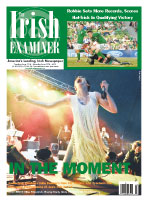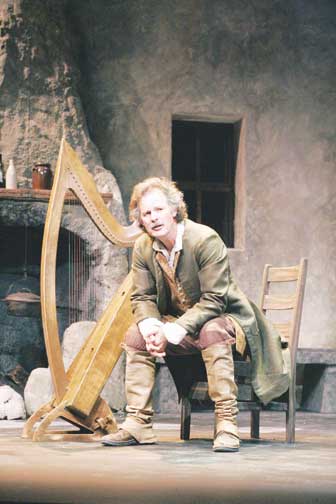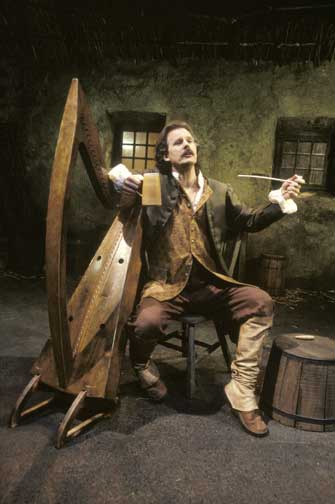


SERVICES
Tuesday November 17, 2009
Patrick Ball Brings O'Carolan To The Tri-State!
By Gwen Orel You have probably heard some tunes by Turlough O'Carolan (1670 -1738)-Planxty Irwin, Eleanor Plunkett, O'Carolan's Concerto, Sí Bheag, Sí Mhór, to name a few. But chances are you haven't heard them as the blind 18th century harper played them - on a wire-strung harp. Patrick Ball offers that opportunity to tri-state trad fans this weekend. On Friday, November 20th, he performs his one-man show O'Carolan's Farewell to Music at the Morristown Unitarian Fellowship, as part of the Minstrel Coffeehouse weekly series presented by the Folk Project of New Jersey (details at 973-335-9489, www.folkproject.org). The next night, Ball performs the show in Cumberland, Rhode Island. On Sunday November 22, Ball will present a master class and concert at the Irish Arts Center in New York (details on the class at 212-757-3318 ext. 209, and at www.irishartscenter.org). The Minstrel does not accept reservations in advance; the show begins at 8:00. At the Irish Arts Center the Master Class begins at 2 and the concert begins at 7. In New Jersey, Ball, who has recorded nine instrumental and three spoken word albums, will show off not just O'Carolan's music, but the man himself. Ball will appear in period costume as Charles McCabe, O'Carolan's close friend and companion, telling stories about his travels with the great Irish bard, and playing O'Carolan tunes. Says Mike Agranoff, who runs the Minstrel Coffee House series, "the show will be a high point in our calendar. Not only is Patrick Ball regarded at the very top of his field, but also the theatrical nature of this performance will distinguish it from the rest of what is usually a concert series." Ball described his attraction to the composer en route to a performance in Branford, Connecticut, on Saturday, "I knew the time O'Carolan lived in was really dark and brutal. I also knew that he was blind, and had his own darkness to deal with. Yet he wrote these very beautiful pieces of music. I was fascinated by how somebody could have the strength of character and spiritual willpower to pull this off." After being blinded by a case of smallpox, O'Carolan took up the harp at age 18. Considered the last of the great Irish bards, he composed music for the gentry, often staying with them as he traveled through the country. Though many traditional musicians play his tunes, O'Carolan was not a folk musician. It is a sore point for some teachers and students when at competitions they hear that an O'Carolan tune is not traditional. While that's true, Ball clarified that O'Carolan "was one of the remnants of the harping tradition. His music was regarded as art music, music somebody actually composed." O'Carolan's influences included Italian classical music, Corelli and Vivaldi. Still, O'Carolan was also influenced by "the old harp-playing style which has completely died out." O'Carolan's music couldn't be considered traditional folk music, not played at folk gatherings but for kings and chieftans. "It''s kind of elitist music." But O'Carolan also wrote the music of his times, and "combined early music and this mildy baroque music, and folk tunes too. Blind Mary is very clearly drawn from the folk influence." And in any case, O'Carolan was "very distinctly an Irishman. Anybody that finds fault with him because he did not play folk music is overly picky. He is an icon in Ireland, his face is on the fifty pound note. All the great musicians of our time have played his music without apology. He's one of the shining lights of the Irish creative spirit." Ball took up the harp even later than O'Carolan did - not until graduate school did he first hear the instrument. The Californian began playing in 1980, the date harpmaker Jay Witcher carved inside his harp. "Had I wanted to play the harp even earlier, it was not available." Witcher began making the harps not long before Ball acquired one. Witcher is, according to Ball, the "very first person to begin to make these wire-strung harps after they had died out 200 years ago." Witcher, also a Californian, was an aerospace engineer who'd been laid off, Ball explained, who saw some wire-strung Celtic harps in a private gallery in Dublin. Ball comes from an Irish-American family, but not a traditional music heritage. While pursuing his MA in Irish history, he visited Ireland to look for topics. "As soon as I heard it, I felt a real kinship to the music, particularly to the harp music." He loved Derek Bell's recordings of O'Carolan. As a historian, however, he knew he had not really heard the music as O'Carolan would have played it. "By definition, the harp O'Carolan played, the clairseach, is wire-strung," said Ball. "When people say they play the Celtic harp it could be anything that looks more or less like what I play. Two hundred years ago these harps died out. Harps did not, so people switched to playing harps strung with gut-strings. The tradition carried on but it changed."
O'Carolan's harp would have been strung with brass wire. Significantly, wire-strung harps are played with the fingernails. "If you played with finger pads you'd get very little sound. The strings are very tight - it would be like playing a steel-strung guitar with finger pads." Ball described the difference in the sounds of the harp: "The wire-strung harp tends to float, create marvelous atmospheres. They resonate and ring infinitely longer than the gut-string harp." Ball added, "some arrangements on nylon-strung harps would sound pretty messy, like a dog's breakfast." The wire-strung harp does not usually have sharping levers-O'Carolan's did not, and Ball's does not. When the culture and patronage system changed, harpers had to change with the times, Ball recounted. Harpers had to work as well as play, which made long fingernails impractical. In 1792, there was a famous harp festival in Belfast, to which all the remaining masters of the wire-strung harp were invited-by then, there were only eight, and "only one played with fingernails," Ball recounted. "Ten years later, people had completely given up playing wirestrung harps." In the play, Ball plays Charles McCabe, O'Carolan's companion, attempting to write an elegy six days after the composer's death. McCabe is a historical figure, though "not known as a great poet," said Ball. The play takes place in a shebeen in County Rosscommon. At times, as McCabe recalls his friend, Ball portrays O'Carolan. Peter Glazer, author of Woody Guthrie's American Song and other pieces, wrote the play with Ball. Ball conceived the idea, and Glazer helped Ball shape it into a piece of theatre. Ball has performed it in regional repertory theatres with regular runs and full sets, and also as one-day events like the one that will be in Morristown. "It's in the oral tradition of storytelling, with music." Having the narrator be McCabe, not O'Carolan, adds conflict to the play." O'Carolan was so celebrated an individual, he would play for the English-in those times, there was no stigma about a great artist playing for whomever gave him honor and hospitality. But it was also a time of enormous upheaval. McCabe has great scruples about using art to perform for, essentially, invaders. Even though these two men have a great strong love for each other, they struggle with politics, their feelings for one another and the use of their art." There are no songs in the play, but there are intoned lyrics. "Most people think O'Carolan probably did not sing at all," Ball declared. "The range of pieces he wrote was so wide that even trained singers could not hit those notes." The master class at the Irish Arts Center will offer something very different from the play. It presents the wire-strung harp, but how will depend to some extent on who attends. At workshops at festivals, Ball admitted, "it''s really rare that anybody brings a wire-strung harp. Many people who play the other kind are fascinated by it. I will probably combine talking about the lore and history of the wire-strung harp and how you go about playing it, then if people are interested we will go through a tune and learn how to approach that particular tune." There is a concert following the master class. Though Ball makes his living performing, he doesn't have any students apart from workshops. "It's not an instrument where parents say, I want you to grow up to play the wire-strung harp. It's not as versatile as nylon or gut-string with sharping levers. The other kind of harp is more driving and percussive. It's wonderful as solo and in small ensembles." And then there are the finger-nails. Still, Ball believes that more people would play the wire-strung harp if they heard it. And despite the limited number of players, the wire-strung harp probably won't die out again-people are continuing to build it. And if they build it, it will be played. |
CURRENT ISSUE

RECENT ISSUES


SYNDICATE
[What is this?]
POWERED BY

HOSTED BY

Terms of Service | Privacy Policy
Website Design By C3I







